Hospitality Management: Paris Tourism Policy & Fullerton Hotel Case
VerifiedAdded on 2023/06/08
|22
|5503
|260
Report
AI Summary
This report provides an analysis of hospitality management in the context of Paris tourism policy and a case study of The Fullerton Hotel in Singapore. Part A examines Paris as a major tourist destination, its tourism policies focusing on environmental, socio-cultural, and economic sustainability, and the impact of terrorism on the industry. It also discusses the Butler S Lifecycle Model for analyzing tourist destination development and recommends Agenda 21 for sustainable practices. Part B delves into the history, background, and impact of The Fullerton Hotel in Singapore, covering its economic and social impacts, and applies Gunn’s Theory model to understand its functioning within the tourism system. The report concludes with insights into achieving sustainable tourism and the importance of strategic policy implementation.
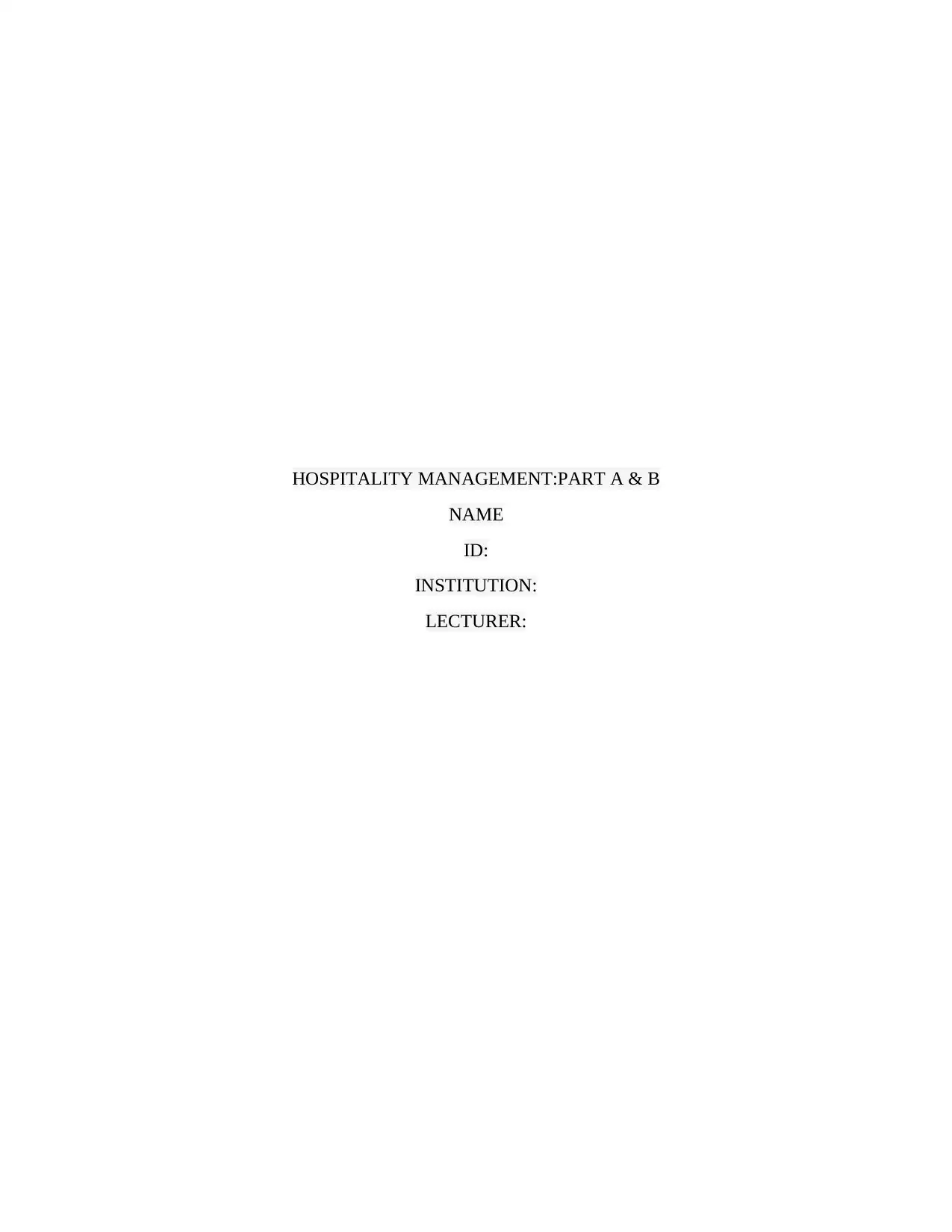
HOSPITALITY MANAGEMENT:PART A & B
NAME
ID:
INSTITUTION:
LECTURER:
NAME
ID:
INSTITUTION:
LECTURER:
Paraphrase This Document
Need a fresh take? Get an instant paraphrase of this document with our AI Paraphraser
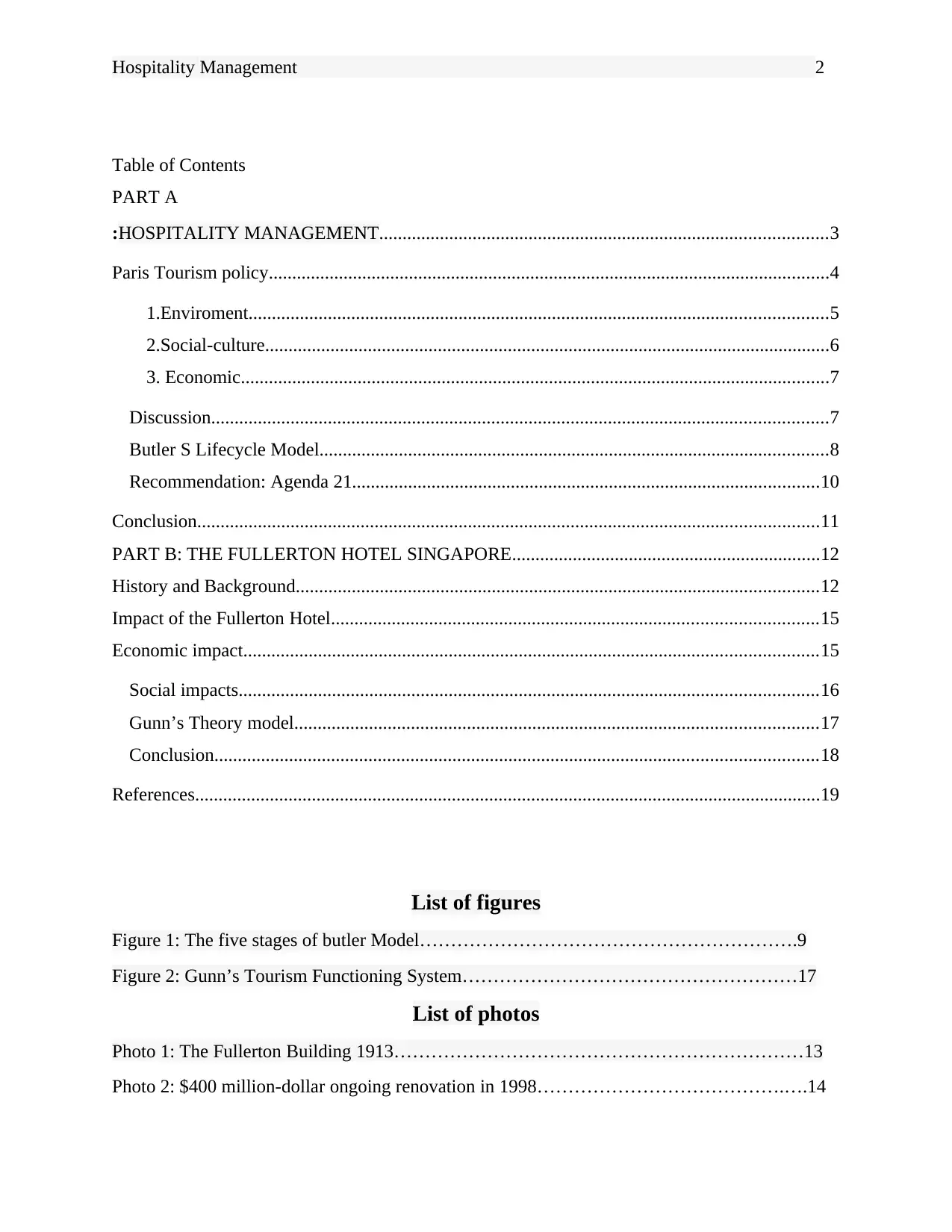
Hospitality Management 2
Table of Contents
PART A
:HOSPITALITY MANAGEMENT................................................................................................3
Paris Tourism policy........................................................................................................................4
1.Enviroment............................................................................................................................5
2.Social-culture.........................................................................................................................6
3. Economic..............................................................................................................................7
Discussion....................................................................................................................................7
Butler S Lifecycle Model.............................................................................................................8
Recommendation: Agenda 21....................................................................................................10
Conclusion.....................................................................................................................................11
PART B: THE FULLERTON HOTEL SINGAPORE..................................................................12
History and Background................................................................................................................12
Impact of the Fullerton Hotel........................................................................................................15
Economic impact...........................................................................................................................15
Social impacts............................................................................................................................16
Gunn’s Theory model................................................................................................................17
Conclusion.................................................................................................................................18
References......................................................................................................................................19
List of figures
Figure 1: The five stages of butler Model…………………………………………………….9
Figure 2: Gunn’s Tourism Functioning System………………………………………………17
List of photos
Photo 1: The Fullerton Building 1913…………………………………………………………13
Photo 2: $400 million-dollar ongoing renovation in 1998………………………………….….14
Table of Contents
PART A
:HOSPITALITY MANAGEMENT................................................................................................3
Paris Tourism policy........................................................................................................................4
1.Enviroment............................................................................................................................5
2.Social-culture.........................................................................................................................6
3. Economic..............................................................................................................................7
Discussion....................................................................................................................................7
Butler S Lifecycle Model.............................................................................................................8
Recommendation: Agenda 21....................................................................................................10
Conclusion.....................................................................................................................................11
PART B: THE FULLERTON HOTEL SINGAPORE..................................................................12
History and Background................................................................................................................12
Impact of the Fullerton Hotel........................................................................................................15
Economic impact...........................................................................................................................15
Social impacts............................................................................................................................16
Gunn’s Theory model................................................................................................................17
Conclusion.................................................................................................................................18
References......................................................................................................................................19
List of figures
Figure 1: The five stages of butler Model…………………………………………………….9
Figure 2: Gunn’s Tourism Functioning System………………………………………………17
List of photos
Photo 1: The Fullerton Building 1913…………………………………………………………13
Photo 2: $400 million-dollar ongoing renovation in 1998………………………………….….14
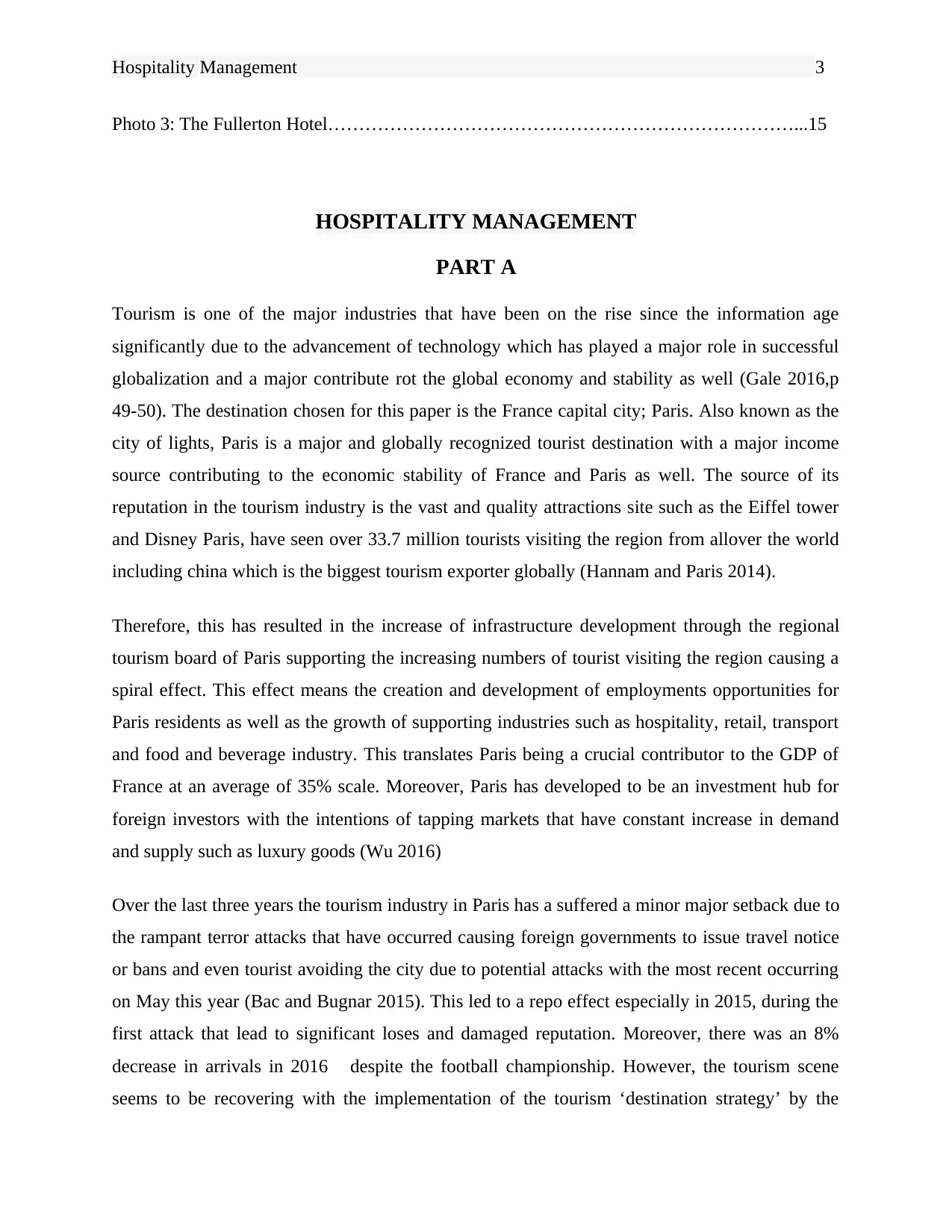
Hospitality Management 3
Photo 3: The Fullerton Hotel…………………………………………………………………...15
HOSPITALITY MANAGEMENT
PART A
Tourism is one of the major industries that have been on the rise since the information age
significantly due to the advancement of technology which has played a major role in successful
globalization and a major contribute rot the global economy and stability as well (Gale 2016,p
49-50). The destination chosen for this paper is the France capital city; Paris. Also known as the
city of lights, Paris is a major and globally recognized tourist destination with a major income
source contributing to the economic stability of France and Paris as well. The source of its
reputation in the tourism industry is the vast and quality attractions site such as the Eiffel tower
and Disney Paris, have seen over 33.7 million tourists visiting the region from allover the world
including china which is the biggest tourism exporter globally (Hannam and Paris 2014).
Therefore, this has resulted in the increase of infrastructure development through the regional
tourism board of Paris supporting the increasing numbers of tourist visiting the region causing a
spiral effect. This effect means the creation and development of employments opportunities for
Paris residents as well as the growth of supporting industries such as hospitality, retail, transport
and food and beverage industry. This translates Paris being a crucial contributor to the GDP of
France at an average of 35% scale. Moreover, Paris has developed to be an investment hub for
foreign investors with the intentions of tapping markets that have constant increase in demand
and supply such as luxury goods (Wu 2016)
Over the last three years the tourism industry in Paris has a suffered a minor major setback due to
the rampant terror attacks that have occurred causing foreign governments to issue travel notice
or bans and even tourist avoiding the city due to potential attacks with the most recent occurring
on May this year (Bac and Bugnar 2015). This led to a repo effect especially in 2015, during the
first attack that lead to significant loses and damaged reputation. Moreover, there was an 8%
decrease in arrivals in 2016 despite the football championship. However, the tourism scene
seems to be recovering with the implementation of the tourism ‘destination strategy’ by the
Photo 3: The Fullerton Hotel…………………………………………………………………...15
HOSPITALITY MANAGEMENT
PART A
Tourism is one of the major industries that have been on the rise since the information age
significantly due to the advancement of technology which has played a major role in successful
globalization and a major contribute rot the global economy and stability as well (Gale 2016,p
49-50). The destination chosen for this paper is the France capital city; Paris. Also known as the
city of lights, Paris is a major and globally recognized tourist destination with a major income
source contributing to the economic stability of France and Paris as well. The source of its
reputation in the tourism industry is the vast and quality attractions site such as the Eiffel tower
and Disney Paris, have seen over 33.7 million tourists visiting the region from allover the world
including china which is the biggest tourism exporter globally (Hannam and Paris 2014).
Therefore, this has resulted in the increase of infrastructure development through the regional
tourism board of Paris supporting the increasing numbers of tourist visiting the region causing a
spiral effect. This effect means the creation and development of employments opportunities for
Paris residents as well as the growth of supporting industries such as hospitality, retail, transport
and food and beverage industry. This translates Paris being a crucial contributor to the GDP of
France at an average of 35% scale. Moreover, Paris has developed to be an investment hub for
foreign investors with the intentions of tapping markets that have constant increase in demand
and supply such as luxury goods (Wu 2016)
Over the last three years the tourism industry in Paris has a suffered a minor major setback due to
the rampant terror attacks that have occurred causing foreign governments to issue travel notice
or bans and even tourist avoiding the city due to potential attacks with the most recent occurring
on May this year (Bac and Bugnar 2015). This led to a repo effect especially in 2015, during the
first attack that lead to significant loses and damaged reputation. Moreover, there was an 8%
decrease in arrivals in 2016 despite the football championship. However, the tourism scene
seems to be recovering with the implementation of the tourism ‘destination strategy’ by the
⊘ This is a preview!⊘
Do you want full access?
Subscribe today to unlock all pages.

Trusted by 1+ million students worldwide
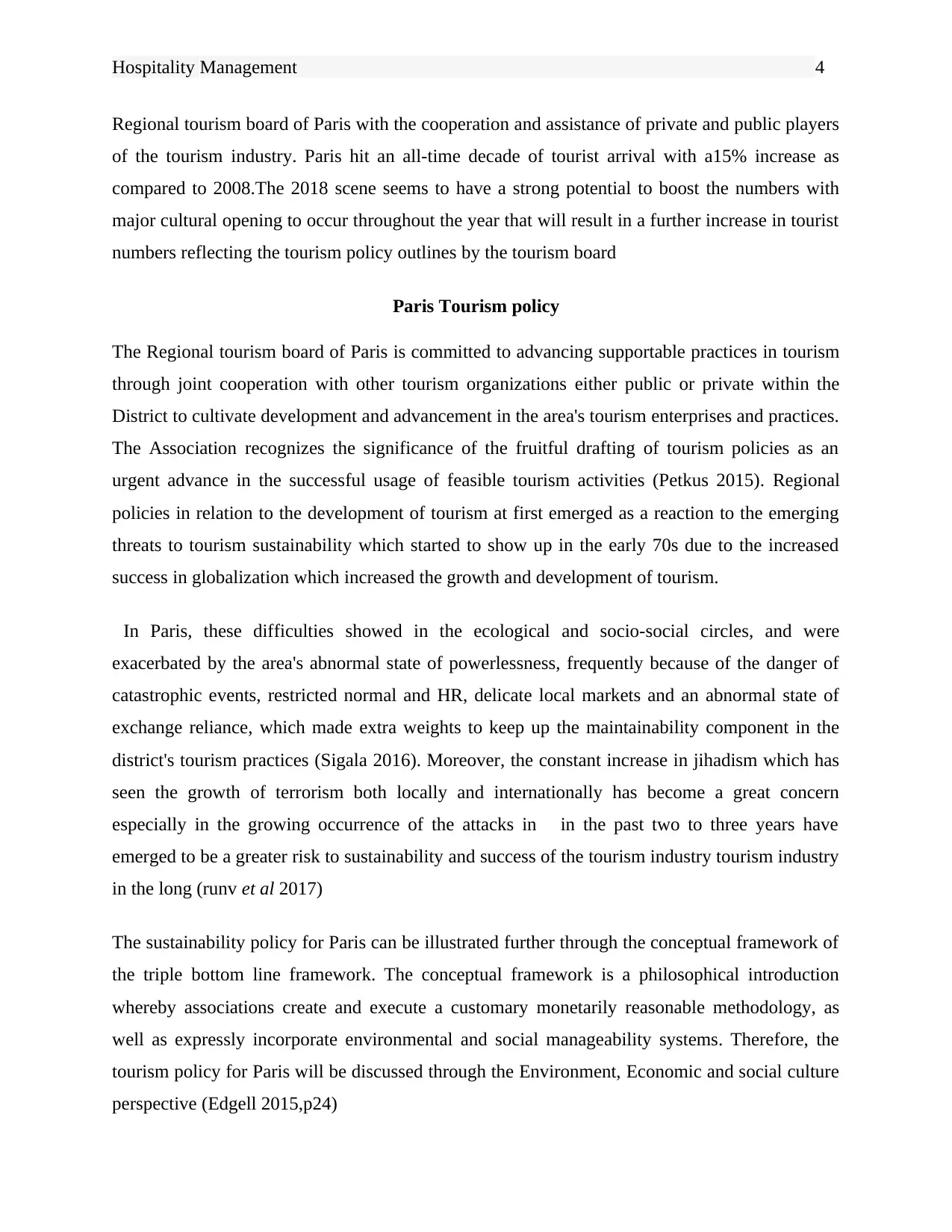
Hospitality Management 4
Regional tourism board of Paris with the cooperation and assistance of private and public players
of the tourism industry. Paris hit an all-time decade of tourist arrival with a15% increase as
compared to 2008.The 2018 scene seems to have a strong potential to boost the numbers with
major cultural opening to occur throughout the year that will result in a further increase in tourist
numbers reflecting the tourism policy outlines by the tourism board
Paris Tourism policy
The Regional tourism board of Paris is committed to advancing supportable practices in tourism
through joint cooperation with other tourism organizations either public or private within the
District to cultivate development and advancement in the area's tourism enterprises and practices.
The Association recognizes the significance of the fruitful drafting of tourism policies as an
urgent advance in the successful usage of feasible tourism activities (Petkus 2015). Regional
policies in relation to the development of tourism at first emerged as a reaction to the emerging
threats to tourism sustainability which started to show up in the early 70s due to the increased
success in globalization which increased the growth and development of tourism.
In Paris, these difficulties showed in the ecological and socio-social circles, and were
exacerbated by the area's abnormal state of powerlessness, frequently because of the danger of
catastrophic events, restricted normal and HR, delicate local markets and an abnormal state of
exchange reliance, which made extra weights to keep up the maintainability component in the
district's tourism practices (Sigala 2016). Moreover, the constant increase in jihadism which has
seen the growth of terrorism both locally and internationally has become a great concern
especially in the growing occurrence of the attacks in in the past two to three years have
emerged to be a greater risk to sustainability and success of the tourism industry tourism industry
in the long (runv et al 2017)
The sustainability policy for Paris can be illustrated further through the conceptual framework of
the triple bottom line framework. The conceptual framework is a philosophical introduction
whereby associations create and execute a customary monetarily reasonable methodology, as
well as expressly incorporate environmental and social manageability systems. Therefore, the
tourism policy for Paris will be discussed through the Environment, Economic and social culture
perspective (Edgell 2015,p24)
Regional tourism board of Paris with the cooperation and assistance of private and public players
of the tourism industry. Paris hit an all-time decade of tourist arrival with a15% increase as
compared to 2008.The 2018 scene seems to have a strong potential to boost the numbers with
major cultural opening to occur throughout the year that will result in a further increase in tourist
numbers reflecting the tourism policy outlines by the tourism board
Paris Tourism policy
The Regional tourism board of Paris is committed to advancing supportable practices in tourism
through joint cooperation with other tourism organizations either public or private within the
District to cultivate development and advancement in the area's tourism enterprises and practices.
The Association recognizes the significance of the fruitful drafting of tourism policies as an
urgent advance in the successful usage of feasible tourism activities (Petkus 2015). Regional
policies in relation to the development of tourism at first emerged as a reaction to the emerging
threats to tourism sustainability which started to show up in the early 70s due to the increased
success in globalization which increased the growth and development of tourism.
In Paris, these difficulties showed in the ecological and socio-social circles, and were
exacerbated by the area's abnormal state of powerlessness, frequently because of the danger of
catastrophic events, restricted normal and HR, delicate local markets and an abnormal state of
exchange reliance, which made extra weights to keep up the maintainability component in the
district's tourism practices (Sigala 2016). Moreover, the constant increase in jihadism which has
seen the growth of terrorism both locally and internationally has become a great concern
especially in the growing occurrence of the attacks in in the past two to three years have
emerged to be a greater risk to sustainability and success of the tourism industry tourism industry
in the long (runv et al 2017)
The sustainability policy for Paris can be illustrated further through the conceptual framework of
the triple bottom line framework. The conceptual framework is a philosophical introduction
whereby associations create and execute a customary monetarily reasonable methodology, as
well as expressly incorporate environmental and social manageability systems. Therefore, the
tourism policy for Paris will be discussed through the Environment, Economic and social culture
perspective (Edgell 2015,p24)
Paraphrase This Document
Need a fresh take? Get an instant paraphrase of this document with our AI Paraphraser
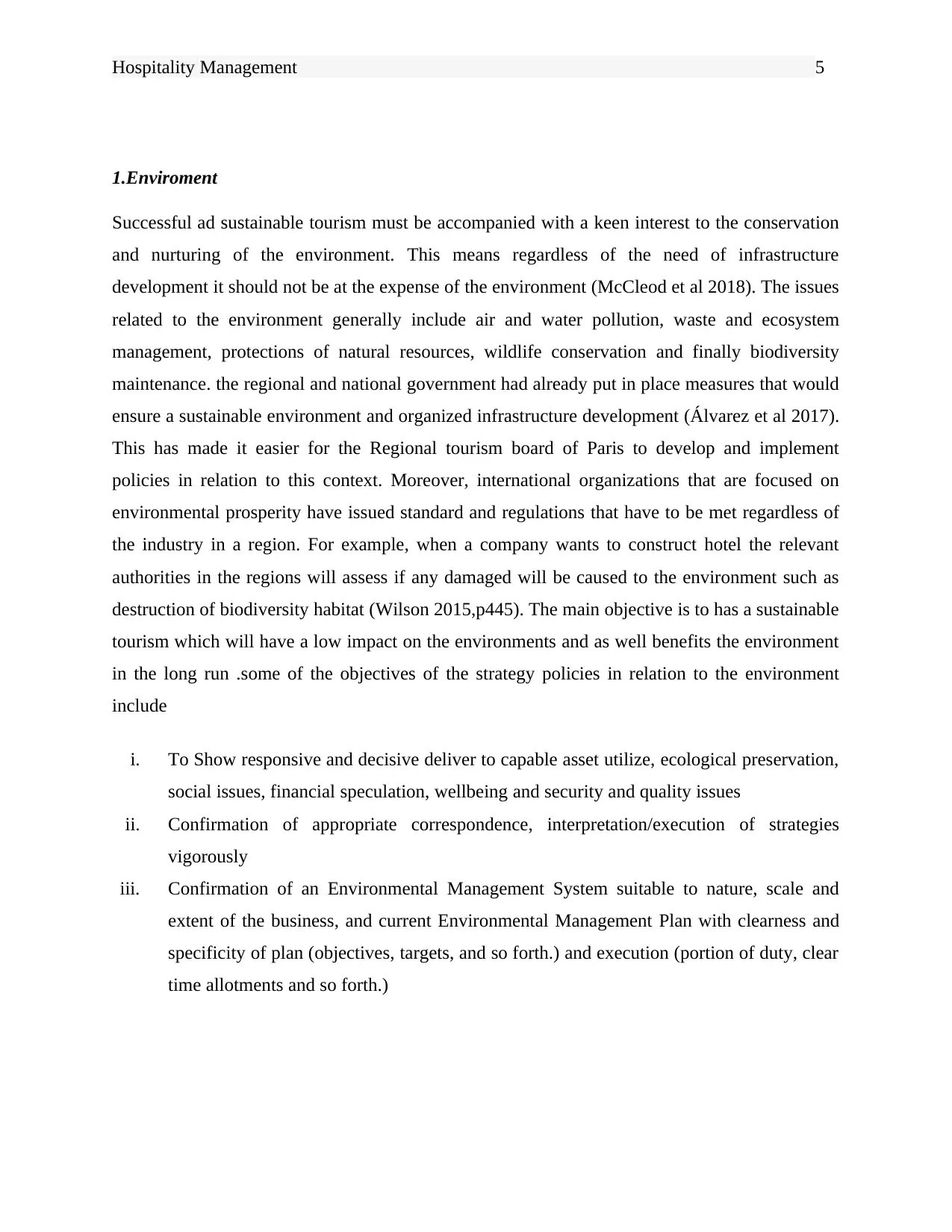
Hospitality Management 5
1.Enviroment
Successful ad sustainable tourism must be accompanied with a keen interest to the conservation
and nurturing of the environment. This means regardless of the need of infrastructure
development it should not be at the expense of the environment (McCleod et al 2018). The issues
related to the environment generally include air and water pollution, waste and ecosystem
management, protections of natural resources, wildlife conservation and finally biodiversity
maintenance. the regional and national government had already put in place measures that would
ensure a sustainable environment and organized infrastructure development (Álvarez et al 2017).
This has made it easier for the Regional tourism board of Paris to develop and implement
policies in relation to this context. Moreover, international organizations that are focused on
environmental prosperity have issued standard and regulations that have to be met regardless of
the industry in a region. For example, when a company wants to construct hotel the relevant
authorities in the regions will assess if any damaged will be caused to the environment such as
destruction of biodiversity habitat (Wilson 2015,p445). The main objective is to has a sustainable
tourism which will have a low impact on the environments and as well benefits the environment
in the long run .some of the objectives of the strategy policies in relation to the environment
include
i. To Show responsive and decisive deliver to capable asset utilize, ecological preservation,
social issues, financial speculation, wellbeing and security and quality issues
ii. Confirmation of appropriate correspondence, interpretation/execution of strategies
vigorously
iii. Confirmation of an Environmental Management System suitable to nature, scale and
extent of the business, and current Environmental Management Plan with clearness and
specificity of plan (objectives, targets, and so forth.) and execution (portion of duty, clear
time allotments and so forth.)
1.Enviroment
Successful ad sustainable tourism must be accompanied with a keen interest to the conservation
and nurturing of the environment. This means regardless of the need of infrastructure
development it should not be at the expense of the environment (McCleod et al 2018). The issues
related to the environment generally include air and water pollution, waste and ecosystem
management, protections of natural resources, wildlife conservation and finally biodiversity
maintenance. the regional and national government had already put in place measures that would
ensure a sustainable environment and organized infrastructure development (Álvarez et al 2017).
This has made it easier for the Regional tourism board of Paris to develop and implement
policies in relation to this context. Moreover, international organizations that are focused on
environmental prosperity have issued standard and regulations that have to be met regardless of
the industry in a region. For example, when a company wants to construct hotel the relevant
authorities in the regions will assess if any damaged will be caused to the environment such as
destruction of biodiversity habitat (Wilson 2015,p445). The main objective is to has a sustainable
tourism which will have a low impact on the environments and as well benefits the environment
in the long run .some of the objectives of the strategy policies in relation to the environment
include
i. To Show responsive and decisive deliver to capable asset utilize, ecological preservation,
social issues, financial speculation, wellbeing and security and quality issues
ii. Confirmation of appropriate correspondence, interpretation/execution of strategies
vigorously
iii. Confirmation of an Environmental Management System suitable to nature, scale and
extent of the business, and current Environmental Management Plan with clearness and
specificity of plan (objectives, targets, and so forth.) and execution (portion of duty, clear
time allotments and so forth.)
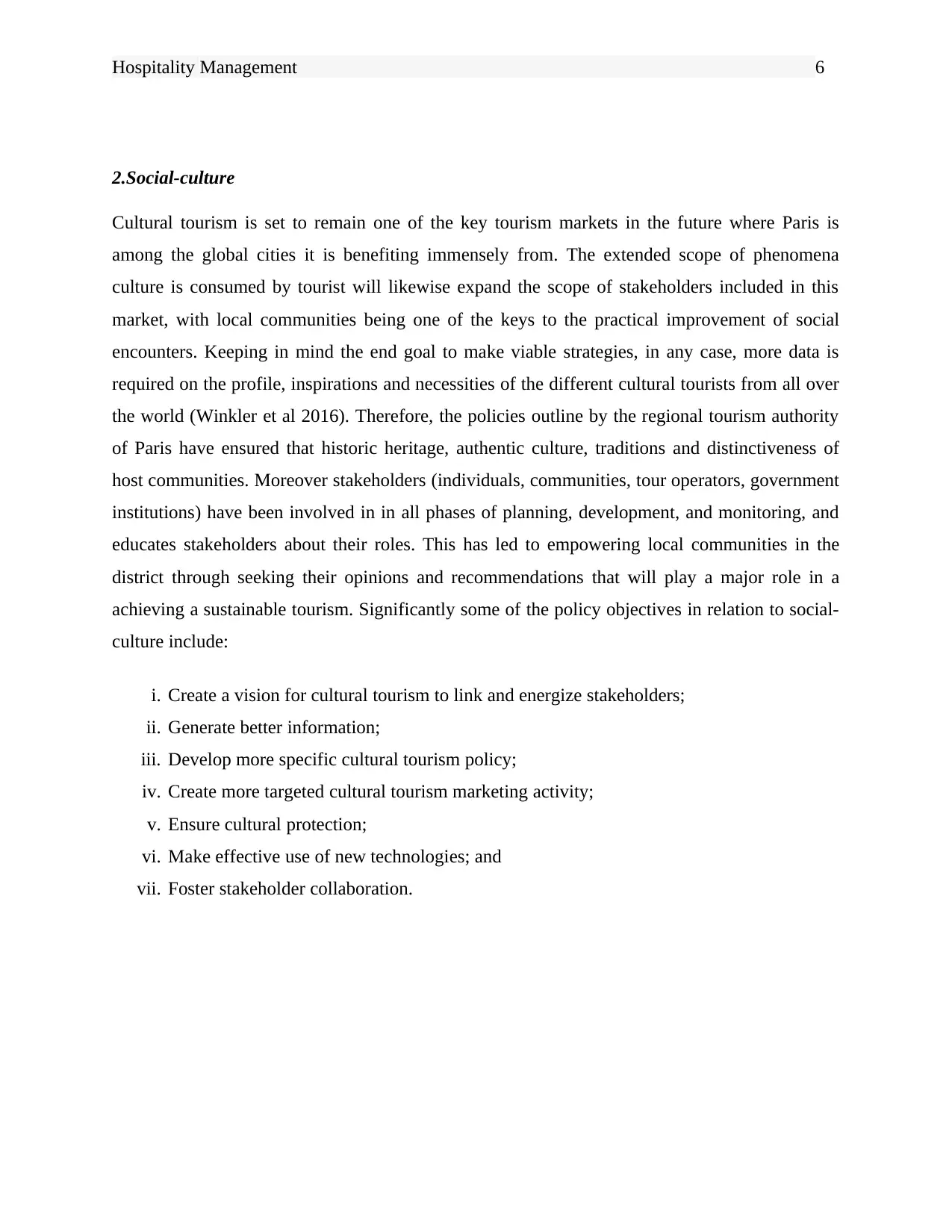
Hospitality Management 6
2.Social-culture
Cultural tourism is set to remain one of the key tourism markets in the future where Paris is
among the global cities it is benefiting immensely from. The extended scope of phenomena
culture is consumed by tourist will likewise expand the scope of stakeholders included in this
market, with local communities being one of the keys to the practical improvement of social
encounters. Keeping in mind the end goal to make viable strategies, in any case, more data is
required on the profile, inspirations and necessities of the different cultural tourists from all over
the world (Winkler et al 2016). Therefore, the policies outline by the regional tourism authority
of Paris have ensured that historic heritage, authentic culture, traditions and distinctiveness of
host communities. Moreover stakeholders (individuals, communities, tour operators, government
institutions) have been involved in in all phases of planning, development, and monitoring, and
educates stakeholders about their roles. This has led to empowering local communities in the
district through seeking their opinions and recommendations that will play a major role in a
achieving a sustainable tourism. Significantly some of the policy objectives in relation to social-
culture include:
i. Create a vision for cultural tourism to link and energize stakeholders;
ii. Generate better information;
iii. Develop more specific cultural tourism policy;
iv. Create more targeted cultural tourism marketing activity;
v. Ensure cultural protection;
vi. Make effective use of new technologies; and
vii. Foster stakeholder collaboration.
2.Social-culture
Cultural tourism is set to remain one of the key tourism markets in the future where Paris is
among the global cities it is benefiting immensely from. The extended scope of phenomena
culture is consumed by tourist will likewise expand the scope of stakeholders included in this
market, with local communities being one of the keys to the practical improvement of social
encounters. Keeping in mind the end goal to make viable strategies, in any case, more data is
required on the profile, inspirations and necessities of the different cultural tourists from all over
the world (Winkler et al 2016). Therefore, the policies outline by the regional tourism authority
of Paris have ensured that historic heritage, authentic culture, traditions and distinctiveness of
host communities. Moreover stakeholders (individuals, communities, tour operators, government
institutions) have been involved in in all phases of planning, development, and monitoring, and
educates stakeholders about their roles. This has led to empowering local communities in the
district through seeking their opinions and recommendations that will play a major role in a
achieving a sustainable tourism. Significantly some of the policy objectives in relation to social-
culture include:
i. Create a vision for cultural tourism to link and energize stakeholders;
ii. Generate better information;
iii. Develop more specific cultural tourism policy;
iv. Create more targeted cultural tourism marketing activity;
v. Ensure cultural protection;
vi. Make effective use of new technologies; and
vii. Foster stakeholder collaboration.
⊘ This is a preview!⊘
Do you want full access?
Subscribe today to unlock all pages.

Trusted by 1+ million students worldwide
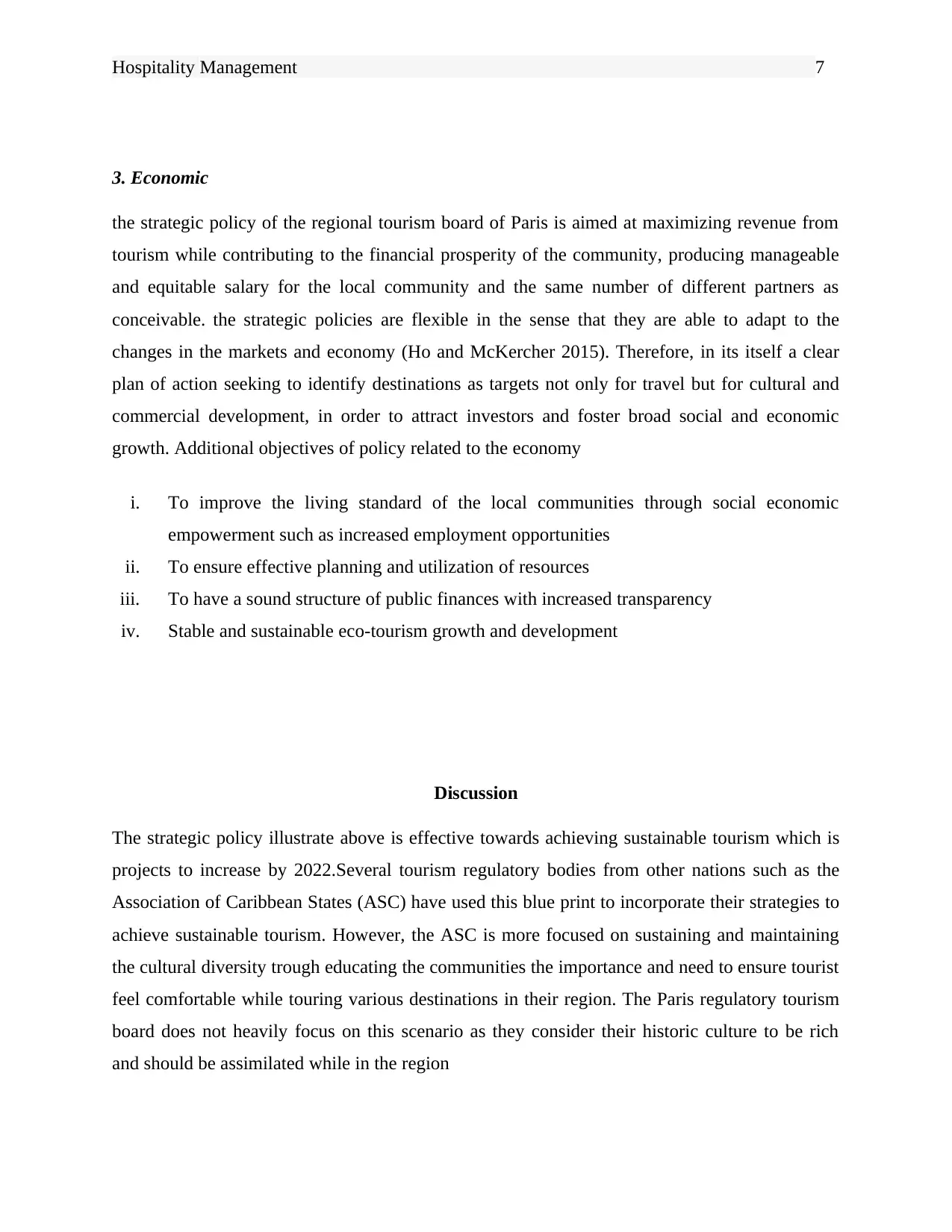
Hospitality Management 7
3. Economic
the strategic policy of the regional tourism board of Paris is aimed at maximizing revenue from
tourism while contributing to the financial prosperity of the community, producing manageable
and equitable salary for the local community and the same number of different partners as
conceivable. the strategic policies are flexible in the sense that they are able to adapt to the
changes in the markets and economy (Ho and McKercher 2015). Therefore, in its itself a clear
plan of action seeking to identify destinations as targets not only for travel but for cultural and
commercial development, in order to attract investors and foster broad social and economic
growth. Additional objectives of policy related to the economy
i. To improve the living standard of the local communities through social economic
empowerment such as increased employment opportunities
ii. To ensure effective planning and utilization of resources
iii. To have a sound structure of public finances with increased transparency
iv. Stable and sustainable eco-tourism growth and development
Discussion
The strategic policy illustrate above is effective towards achieving sustainable tourism which is
projects to increase by 2022.Several tourism regulatory bodies from other nations such as the
Association of Caribbean States (ASC) have used this blue print to incorporate their strategies to
achieve sustainable tourism. However, the ASC is more focused on sustaining and maintaining
the cultural diversity trough educating the communities the importance and need to ensure tourist
feel comfortable while touring various destinations in their region. The Paris regulatory tourism
board does not heavily focus on this scenario as they consider their historic culture to be rich
and should be assimilated while in the region
3. Economic
the strategic policy of the regional tourism board of Paris is aimed at maximizing revenue from
tourism while contributing to the financial prosperity of the community, producing manageable
and equitable salary for the local community and the same number of different partners as
conceivable. the strategic policies are flexible in the sense that they are able to adapt to the
changes in the markets and economy (Ho and McKercher 2015). Therefore, in its itself a clear
plan of action seeking to identify destinations as targets not only for travel but for cultural and
commercial development, in order to attract investors and foster broad social and economic
growth. Additional objectives of policy related to the economy
i. To improve the living standard of the local communities through social economic
empowerment such as increased employment opportunities
ii. To ensure effective planning and utilization of resources
iii. To have a sound structure of public finances with increased transparency
iv. Stable and sustainable eco-tourism growth and development
Discussion
The strategic policy illustrate above is effective towards achieving sustainable tourism which is
projects to increase by 2022.Several tourism regulatory bodies from other nations such as the
Association of Caribbean States (ASC) have used this blue print to incorporate their strategies to
achieve sustainable tourism. However, the ASC is more focused on sustaining and maintaining
the cultural diversity trough educating the communities the importance and need to ensure tourist
feel comfortable while touring various destinations in their region. The Paris regulatory tourism
board does not heavily focus on this scenario as they consider their historic culture to be rich
and should be assimilated while in the region
Paraphrase This Document
Need a fresh take? Get an instant paraphrase of this document with our AI Paraphraser
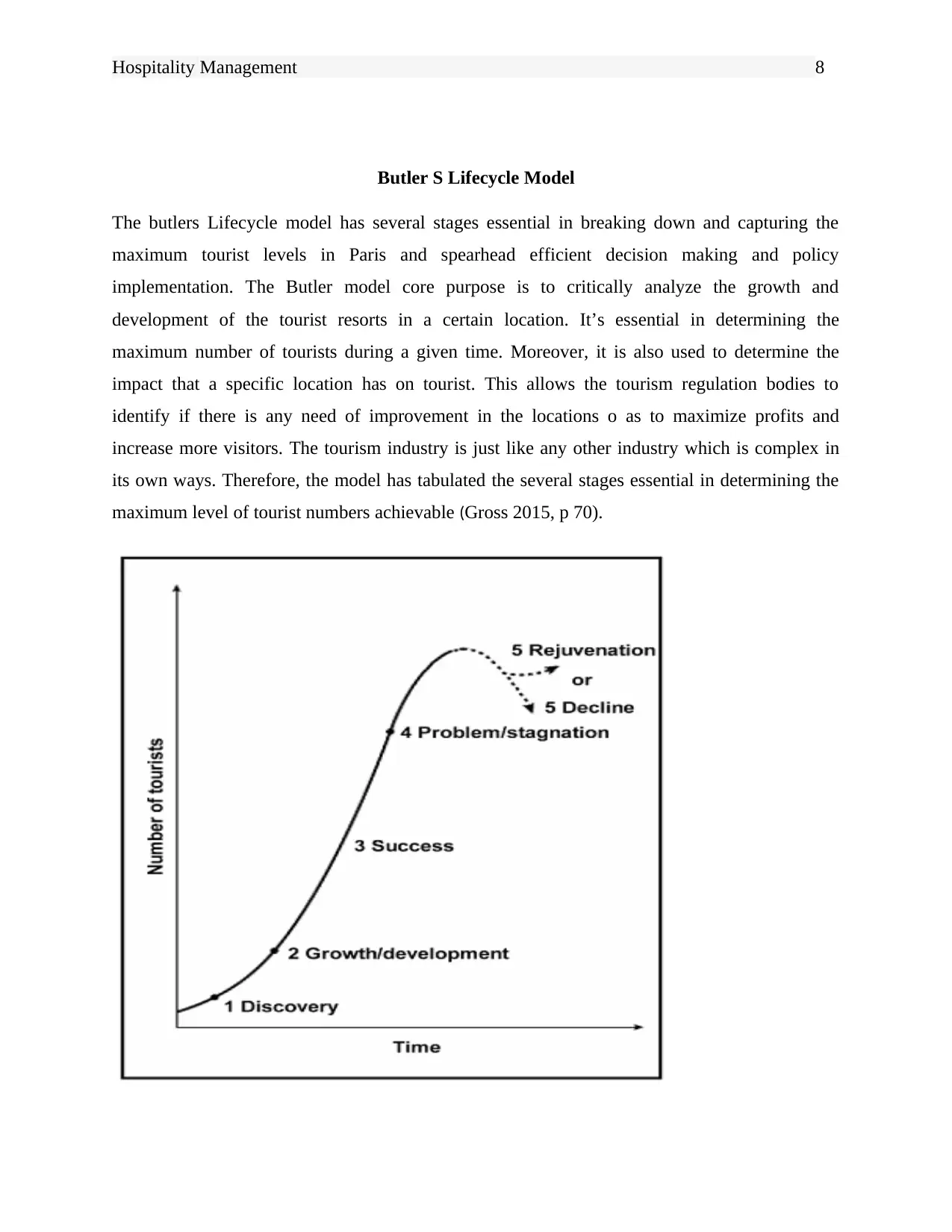
Hospitality Management 8
Butler S Lifecycle Model
The butlers Lifecycle model has several stages essential in breaking down and capturing the
maximum tourist levels in Paris and spearhead efficient decision making and policy
implementation. The Butler model core purpose is to critically analyze the growth and
development of the tourist resorts in a certain location. It’s essential in determining the
maximum number of tourists during a given time. Moreover, it is also used to determine the
impact that a specific location has on tourist. This allows the tourism regulation bodies to
identify if there is any need of improvement in the locations o as to maximize profits and
increase more visitors. The tourism industry is just like any other industry which is complex in
its own ways. Therefore, the model has tabulated the several stages essential in determining the
maximum level of tourist numbers achievable (Gross 2015, p 70).
Butler S Lifecycle Model
The butlers Lifecycle model has several stages essential in breaking down and capturing the
maximum tourist levels in Paris and spearhead efficient decision making and policy
implementation. The Butler model core purpose is to critically analyze the growth and
development of the tourist resorts in a certain location. It’s essential in determining the
maximum number of tourists during a given time. Moreover, it is also used to determine the
impact that a specific location has on tourist. This allows the tourism regulation bodies to
identify if there is any need of improvement in the locations o as to maximize profits and
increase more visitors. The tourism industry is just like any other industry which is complex in
its own ways. Therefore, the model has tabulated the several stages essential in determining the
maximum level of tourist numbers achievable (Gross 2015, p 70).
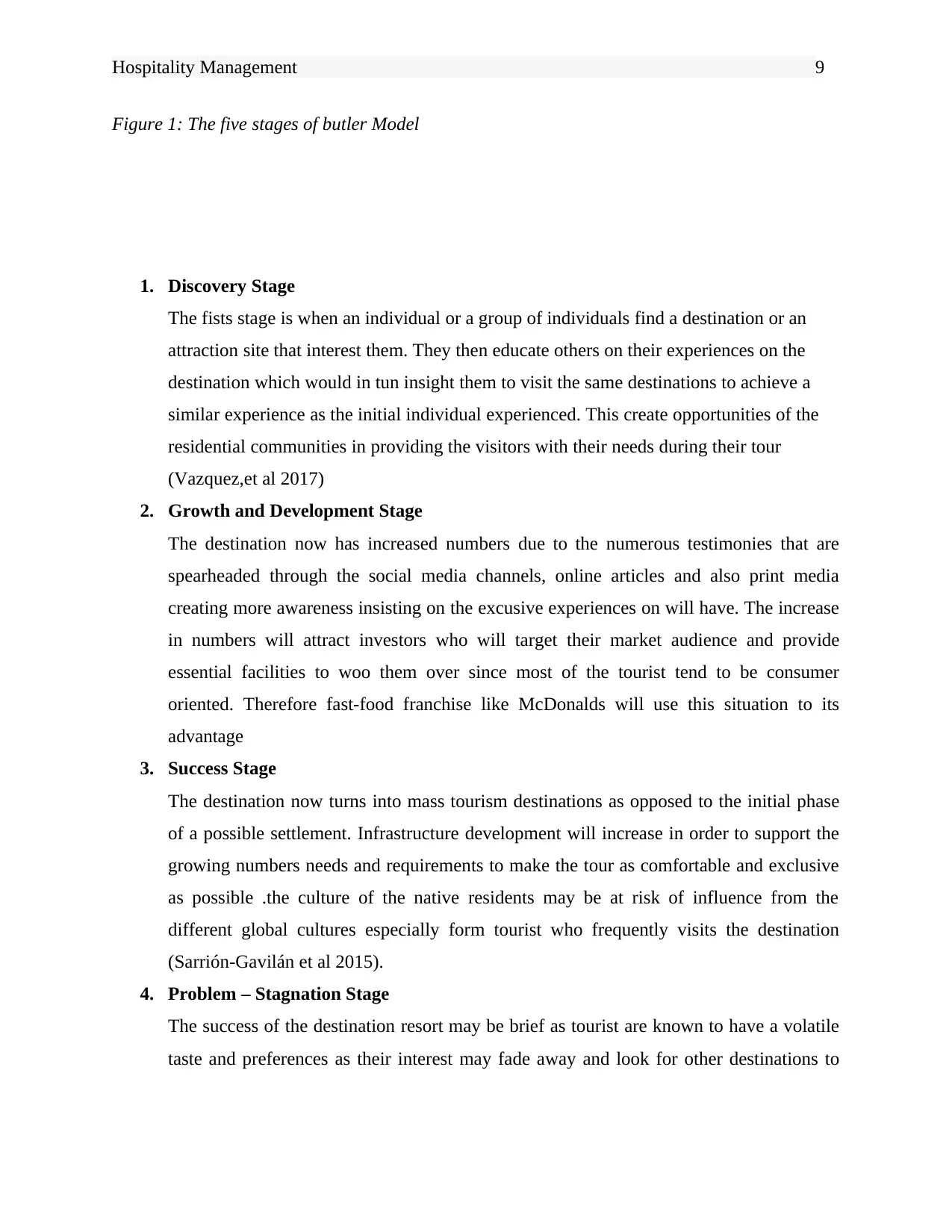
Hospitality Management 9
Figure 1: The five stages of butler Model
1. Discovery Stage
The fists stage is when an individual or a group of individuals find a destination or an
attraction site that interest them. They then educate others on their experiences on the
destination which would in tun insight them to visit the same destinations to achieve a
similar experience as the initial individual experienced. This create opportunities of the
residential communities in providing the visitors with their needs during their tour
(Vazquez,et al 2017)
2. Growth and Development Stage
The destination now has increased numbers due to the numerous testimonies that are
spearheaded through the social media channels, online articles and also print media
creating more awareness insisting on the excusive experiences on will have. The increase
in numbers will attract investors who will target their market audience and provide
essential facilities to woo them over since most of the tourist tend to be consumer
oriented. Therefore fast-food franchise like McDonalds will use this situation to its
advantage
3. Success Stage
The destination now turns into mass tourism destinations as opposed to the initial phase
of a possible settlement. Infrastructure development will increase in order to support the
growing numbers needs and requirements to make the tour as comfortable and exclusive
as possible .the culture of the native residents may be at risk of influence from the
different global cultures especially form tourist who frequently visits the destination
(Sarrión-Gavilán et al 2015).
4. Problem – Stagnation Stage
The success of the destination resort may be brief as tourist are known to have a volatile
taste and preferences as their interest may fade away and look for other destinations to
Figure 1: The five stages of butler Model
1. Discovery Stage
The fists stage is when an individual or a group of individuals find a destination or an
attraction site that interest them. They then educate others on their experiences on the
destination which would in tun insight them to visit the same destinations to achieve a
similar experience as the initial individual experienced. This create opportunities of the
residential communities in providing the visitors with their needs during their tour
(Vazquez,et al 2017)
2. Growth and Development Stage
The destination now has increased numbers due to the numerous testimonies that are
spearheaded through the social media channels, online articles and also print media
creating more awareness insisting on the excusive experiences on will have. The increase
in numbers will attract investors who will target their market audience and provide
essential facilities to woo them over since most of the tourist tend to be consumer
oriented. Therefore fast-food franchise like McDonalds will use this situation to its
advantage
3. Success Stage
The destination now turns into mass tourism destinations as opposed to the initial phase
of a possible settlement. Infrastructure development will increase in order to support the
growing numbers needs and requirements to make the tour as comfortable and exclusive
as possible .the culture of the native residents may be at risk of influence from the
different global cultures especially form tourist who frequently visits the destination
(Sarrión-Gavilán et al 2015).
4. Problem – Stagnation Stage
The success of the destination resort may be brief as tourist are known to have a volatile
taste and preferences as their interest may fade away and look for other destinations to
⊘ This is a preview!⊘
Do you want full access?
Subscribe today to unlock all pages.

Trusted by 1+ million students worldwide
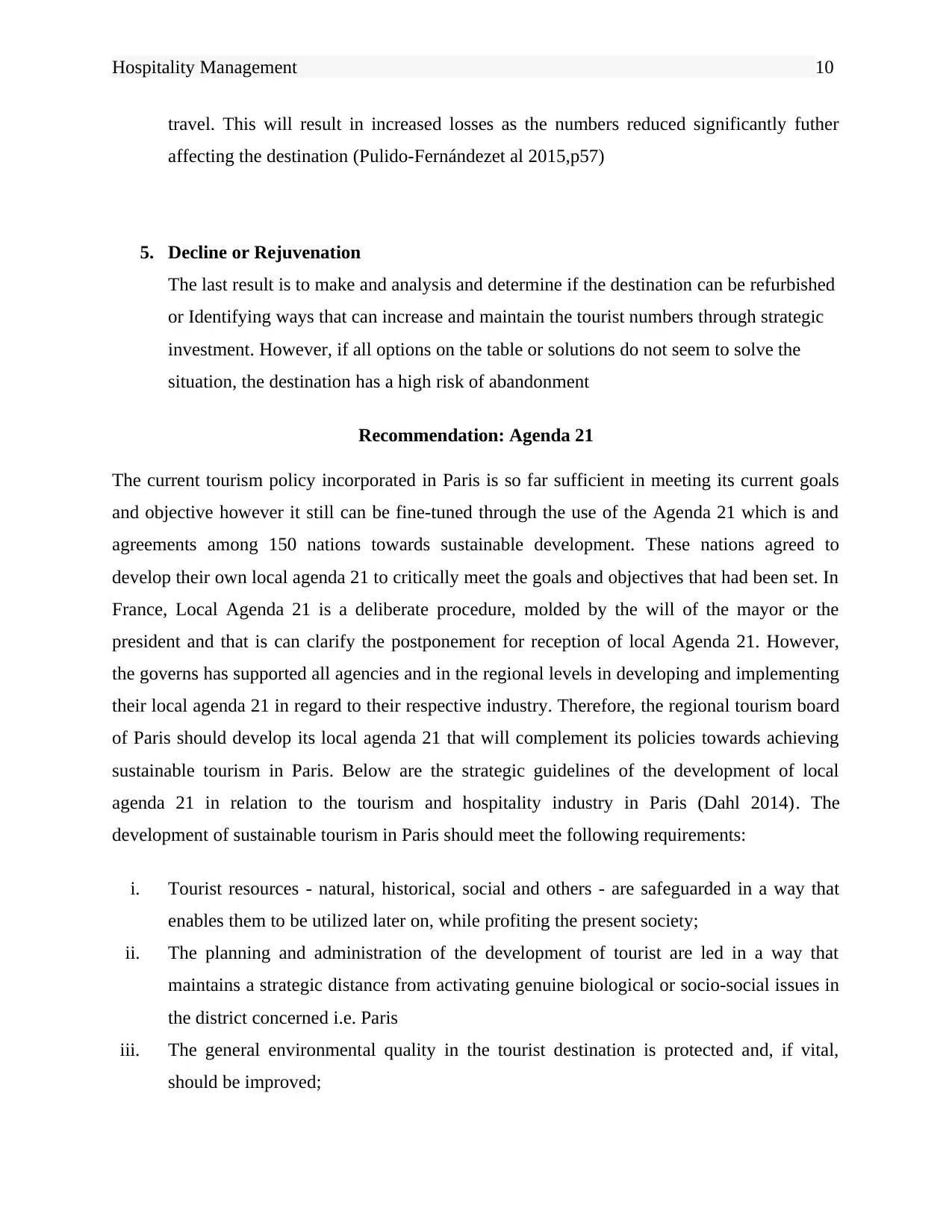
Hospitality Management 10
travel. This will result in increased losses as the numbers reduced significantly futher
affecting the destination (Pulido-Fernándezet al 2015,p57)
5. Decline or Rejuvenation
The last result is to make and analysis and determine if the destination can be refurbished
or Identifying ways that can increase and maintain the tourist numbers through strategic
investment. However, if all options on the table or solutions do not seem to solve the
situation, the destination has a high risk of abandonment
Recommendation: Agenda 21
The current tourism policy incorporated in Paris is so far sufficient in meeting its current goals
and objective however it still can be fine-tuned through the use of the Agenda 21 which is and
agreements among 150 nations towards sustainable development. These nations agreed to
develop their own local agenda 21 to critically meet the goals and objectives that had been set. In
France, Local Agenda 21 is a deliberate procedure, molded by the will of the mayor or the
president and that is can clarify the postponement for reception of local Agenda 21. However,
the governs has supported all agencies and in the regional levels in developing and implementing
their local agenda 21 in regard to their respective industry. Therefore, the regional tourism board
of Paris should develop its local agenda 21 that will complement its policies towards achieving
sustainable tourism in Paris. Below are the strategic guidelines of the development of local
agenda 21 in relation to the tourism and hospitality industry in Paris (Dahl 2014). The
development of sustainable tourism in Paris should meet the following requirements:
i. Tourist resources - natural, historical, social and others - are safeguarded in a way that
enables them to be utilized later on, while profiting the present society;
ii. The planning and administration of the development of tourist are led in a way that
maintains a strategic distance from activating genuine biological or socio-social issues in
the district concerned i.e. Paris
iii. The general environmental quality in the tourist destination is protected and, if vital,
should be improved;
travel. This will result in increased losses as the numbers reduced significantly futher
affecting the destination (Pulido-Fernándezet al 2015,p57)
5. Decline or Rejuvenation
The last result is to make and analysis and determine if the destination can be refurbished
or Identifying ways that can increase and maintain the tourist numbers through strategic
investment. However, if all options on the table or solutions do not seem to solve the
situation, the destination has a high risk of abandonment
Recommendation: Agenda 21
The current tourism policy incorporated in Paris is so far sufficient in meeting its current goals
and objective however it still can be fine-tuned through the use of the Agenda 21 which is and
agreements among 150 nations towards sustainable development. These nations agreed to
develop their own local agenda 21 to critically meet the goals and objectives that had been set. In
France, Local Agenda 21 is a deliberate procedure, molded by the will of the mayor or the
president and that is can clarify the postponement for reception of local Agenda 21. However,
the governs has supported all agencies and in the regional levels in developing and implementing
their local agenda 21 in regard to their respective industry. Therefore, the regional tourism board
of Paris should develop its local agenda 21 that will complement its policies towards achieving
sustainable tourism in Paris. Below are the strategic guidelines of the development of local
agenda 21 in relation to the tourism and hospitality industry in Paris (Dahl 2014). The
development of sustainable tourism in Paris should meet the following requirements:
i. Tourist resources - natural, historical, social and others - are safeguarded in a way that
enables them to be utilized later on, while profiting the present society;
ii. The planning and administration of the development of tourist are led in a way that
maintains a strategic distance from activating genuine biological or socio-social issues in
the district concerned i.e. Paris
iii. The general environmental quality in the tourist destination is protected and, if vital,
should be improved;
Paraphrase This Document
Need a fresh take? Get an instant paraphrase of this document with our AI Paraphraser
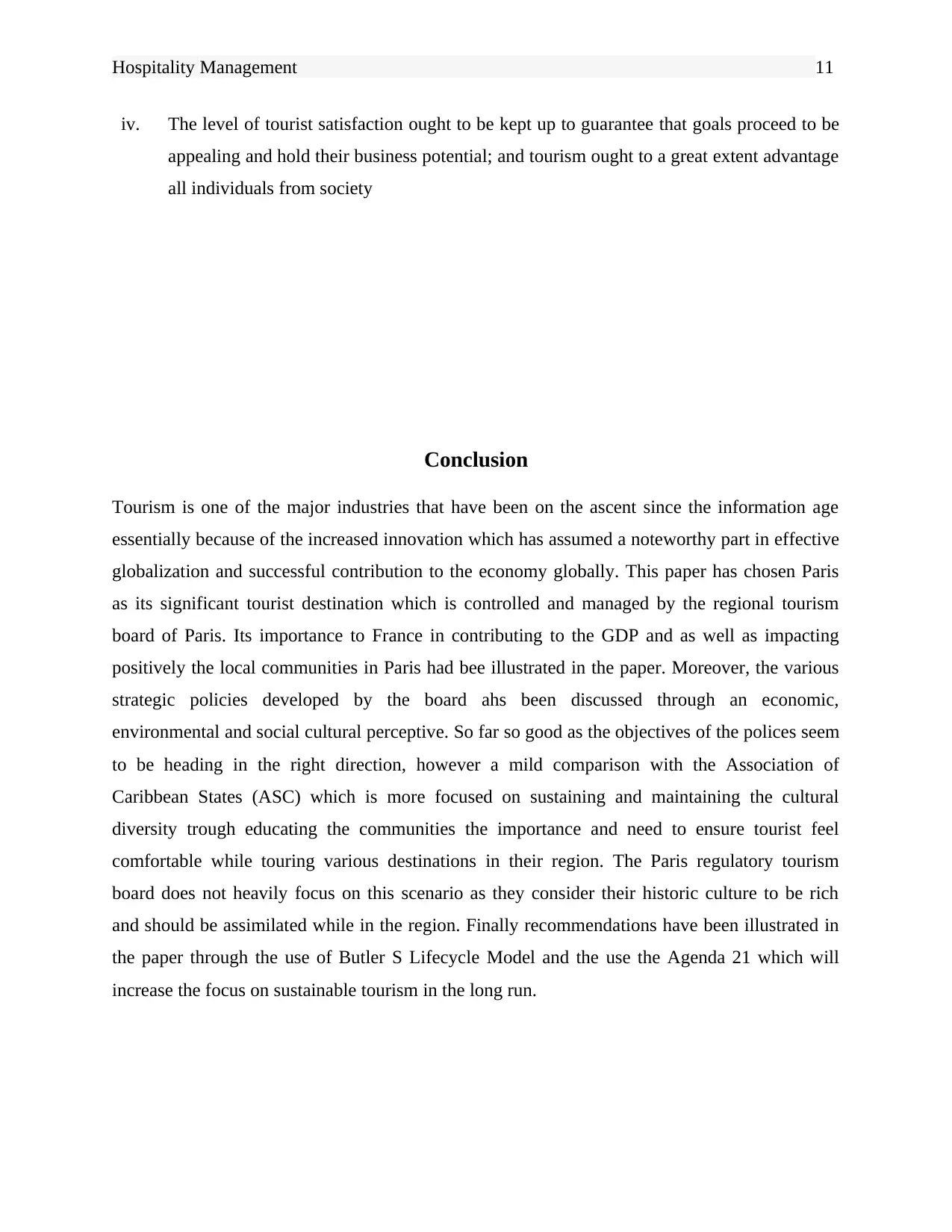
Hospitality Management 11
iv. The level of tourist satisfaction ought to be kept up to guarantee that goals proceed to be
appealing and hold their business potential; and tourism ought to a great extent advantage
all individuals from society
Conclusion
Tourism is one of the major industries that have been on the ascent since the information age
essentially because of the increased innovation which has assumed a noteworthy part in effective
globalization and successful contribution to the economy globally. This paper has chosen Paris
as its significant tourist destination which is controlled and managed by the regional tourism
board of Paris. Its importance to France in contributing to the GDP and as well as impacting
positively the local communities in Paris had bee illustrated in the paper. Moreover, the various
strategic policies developed by the board ahs been discussed through an economic,
environmental and social cultural perceptive. So far so good as the objectives of the polices seem
to be heading in the right direction, however a mild comparison with the Association of
Caribbean States (ASC) which is more focused on sustaining and maintaining the cultural
diversity trough educating the communities the importance and need to ensure tourist feel
comfortable while touring various destinations in their region. The Paris regulatory tourism
board does not heavily focus on this scenario as they consider their historic culture to be rich
and should be assimilated while in the region. Finally recommendations have been illustrated in
the paper through the use of Butler S Lifecycle Model and the use the Agenda 21 which will
increase the focus on sustainable tourism in the long run.
iv. The level of tourist satisfaction ought to be kept up to guarantee that goals proceed to be
appealing and hold their business potential; and tourism ought to a great extent advantage
all individuals from society
Conclusion
Tourism is one of the major industries that have been on the ascent since the information age
essentially because of the increased innovation which has assumed a noteworthy part in effective
globalization and successful contribution to the economy globally. This paper has chosen Paris
as its significant tourist destination which is controlled and managed by the regional tourism
board of Paris. Its importance to France in contributing to the GDP and as well as impacting
positively the local communities in Paris had bee illustrated in the paper. Moreover, the various
strategic policies developed by the board ahs been discussed through an economic,
environmental and social cultural perceptive. So far so good as the objectives of the polices seem
to be heading in the right direction, however a mild comparison with the Association of
Caribbean States (ASC) which is more focused on sustaining and maintaining the cultural
diversity trough educating the communities the importance and need to ensure tourist feel
comfortable while touring various destinations in their region. The Paris regulatory tourism
board does not heavily focus on this scenario as they consider their historic culture to be rich
and should be assimilated while in the region. Finally recommendations have been illustrated in
the paper through the use of Butler S Lifecycle Model and the use the Agenda 21 which will
increase the focus on sustainable tourism in the long run.
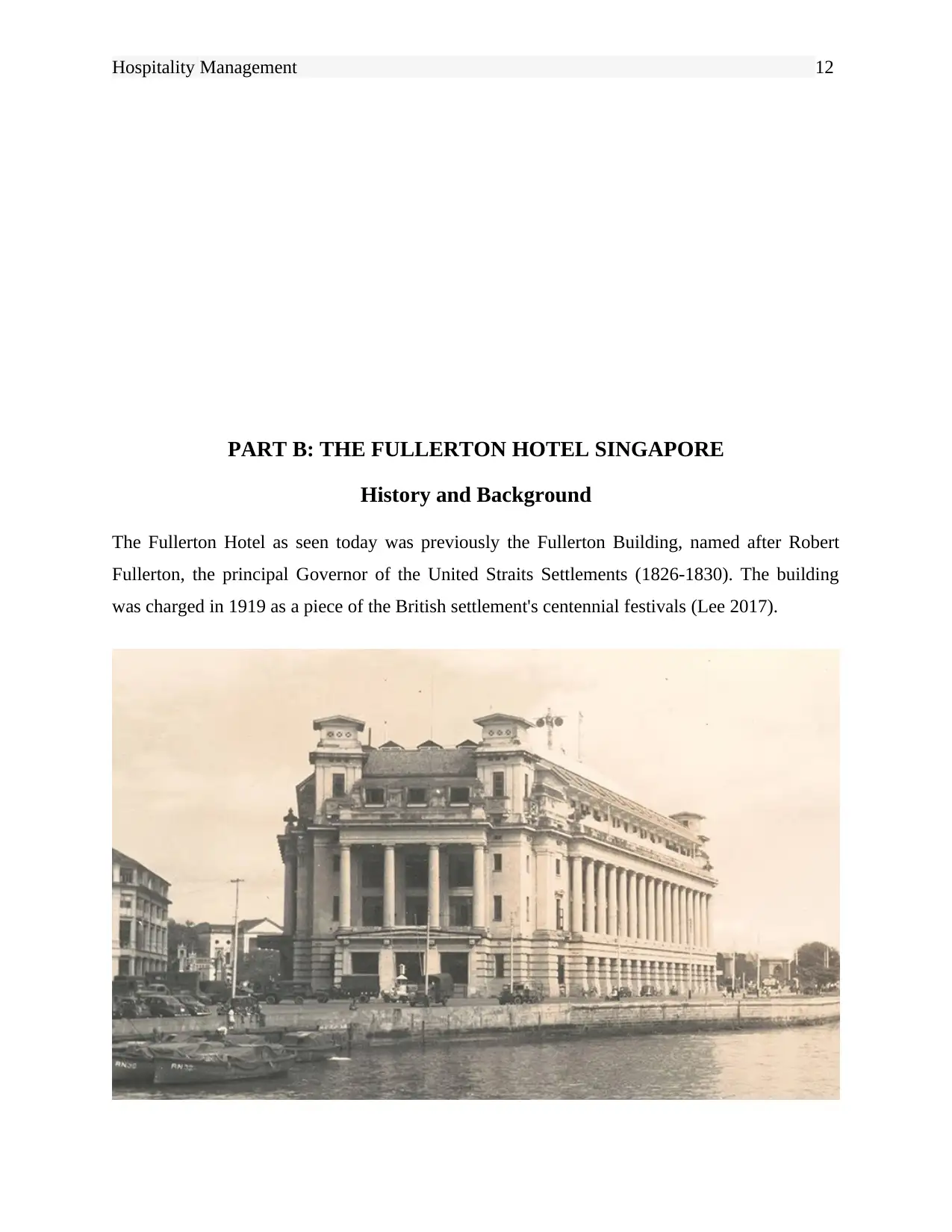
Hospitality Management 12
PART B: THE FULLERTON HOTEL SINGAPORE
History and Background
The Fullerton Hotel as seen today was previously the Fullerton Building, named after Robert
Fullerton, the principal Governor of the United Straits Settlements (1826-1830). The building
was charged in 1919 as a piece of the British settlement's centennial festivals (Lee 2017).
PART B: THE FULLERTON HOTEL SINGAPORE
History and Background
The Fullerton Hotel as seen today was previously the Fullerton Building, named after Robert
Fullerton, the principal Governor of the United Straits Settlements (1826-1830). The building
was charged in 1919 as a piece of the British settlement's centennial festivals (Lee 2017).
⊘ This is a preview!⊘
Do you want full access?
Subscribe today to unlock all pages.

Trusted by 1+ million students worldwide
1 out of 22
Related Documents
Your All-in-One AI-Powered Toolkit for Academic Success.
+13062052269
info@desklib.com
Available 24*7 on WhatsApp / Email
![[object Object]](/_next/static/media/star-bottom.7253800d.svg)
Unlock your academic potential
Copyright © 2020–2025 A2Z Services. All Rights Reserved. Developed and managed by ZUCOL.





